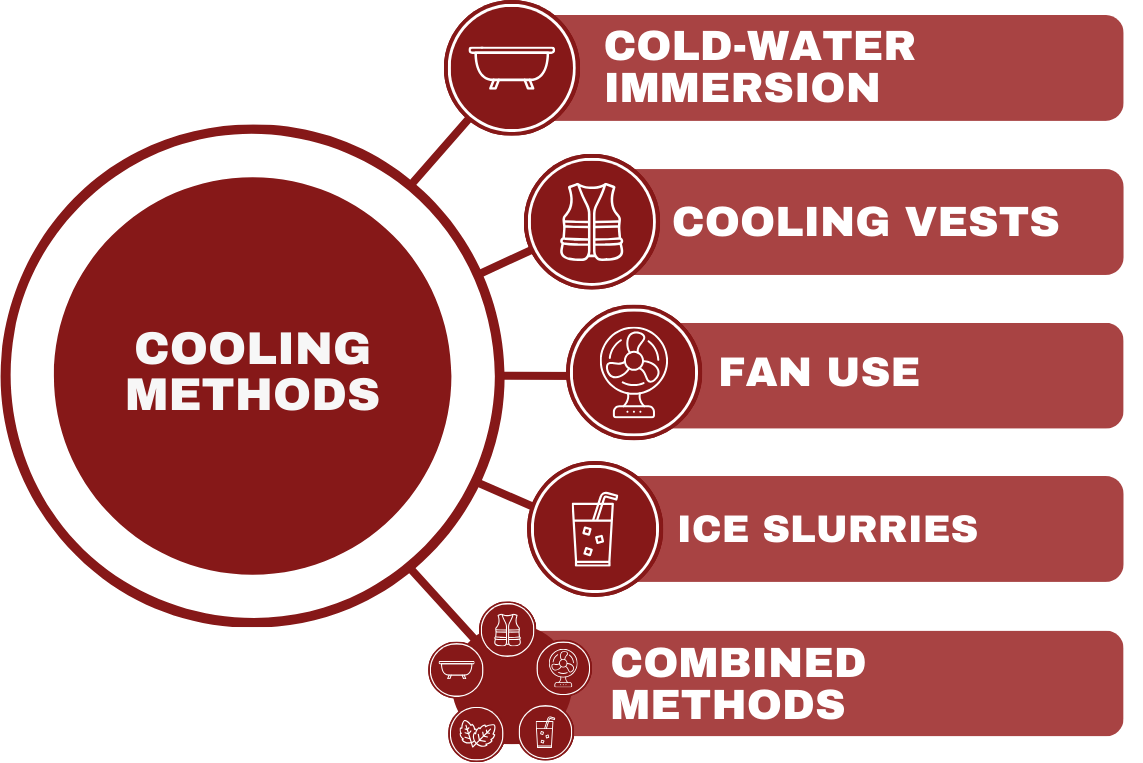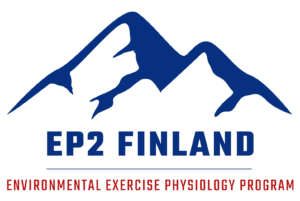Heat presents unique physiological challenges for athletes and prolonged exposure to high temperatures can reduce muscle force and power production, accelerate fatigue, impair decision-making, and increase the risk of heat-related illnesses.1 While the effects of heat stress cannot usually be eliminated entirely, it can be effectively managed with careful preparation and strategies.
Pre-cooling (before exercise) and per-cooling (during exercise) are practical tools that can help athletes start cooler, stay cooler, and ultimately perform better. These methods aim to reduce core and skin temperature, delaying the effects of heat-related fatigue, and improving thermal comfort and physical performance in hot environments. When applied effectively, cooling strategies do not only support athletic efforts but also reduce the likelihood of heat-related illnesses.1,2 Their effectiveness, however, depends on several factors, including the timing, duration of use, environmental conditions, and method and intensity of application making it essential for coaches and athletes to understand how and when to use them.
Cooling Before and During Activity
Pre-cooling
Pre-cooling involves lowering skin and core temperatures before exercise to create a thermal buffer that delays the onset of heat-related fatigue and performance detriment in hot environments. By starting with a reduced body temperature, athletes are able to perform longer or at a higher intensity before reaching critical temperature thresholds that impair performance or lead to exhaustion. This strategy is especially effective for prolonged endurance exercise in the heat, but meaningful improvements have been observed in intermittent performance as well (such as those often seen in team sports), where heat stress is cumulated during subsequent work phases.3 Pre-cooling techniques have been shown to enhance performance by approximately 5.7% on average, specifically in these endurance and intermittent events.5 It is, however, vital to recognize that the demands of the activity, such as duration of the event or work and rest intervals as well as the work intensity, as they play a key role in determining whether pre-cooling will be effective.
In high-intensity and short-duration efforts that rely on maximal power production and high velocity – such as single isolated sprints, jumps, or other explosive movements – pre-cooling may unnecessarily lower muscle temperature, potentially impairing muscle function and reducing power output. In addition, cooling the body’s core too much can decrease voluntary muscle activation and thus physical performance in these events even if muscle temperature is maintained.4 Athletes taking part in short duration, high power output sports may still gain benefits from pre-cooling, if athletes are exposed to excessive heat before their event, i.e., during long waiting times, provided that the cooling method does not directly reduce the temperature of the working muscles and adequate sport-specific warm-up is completed before the event.
Per-cooling
Per-cooling refers to cooling interventions applied during exercise to help limit the increase in core and skin temperature, and thermal discomfort, and it has the potential to attenuate the heat-related detriments to physical performance.1,2,3 These strategies can be especially valuable and practical in sports or events that allow for natural breaks or pauses, like between sets, quarters, or points. In continuous endurance events, brief opportunities to apply cooling may help sustain performance as the event progresses. On average a 9.3% performance improvement has been observed across different per-cooling strategies.5 As with pre-cooling, the importance of per-cooling is emphasized with increasing environmental temperature, but the intensity and duration of the effort, and the cooling strategy used are just as relevant factors as benefits may be very limited or non-existent during short-duration events. Nonetheless, for athletes competing or training in the heat for longer periods of time per-cooling represents a potential strategy to reduce heat strain and preserve performance.
Effectiveness of Different Cooling Methods
The cooling method of choice impacts the outcomes. When using external cooling methods such as vests, collars or ice packs, the covered surface area may contribute to the overall effect. Cooling smaller areas, such as the head, face, and neck, has been shown to improve thermal sensation and comfort in the heat, but its effect on self-paced physical performance has been negligible.6 For athletes preparing to compete in the heat, the most effective approach is to use methods that cool a large surface area and, where possible, to combine external and internal cooling strategies for maximum benefit.7
Although large average improvements of 5.7 % and 9.3 % have been reported for different pre- and per-cooling methods5, It is important to remember, however, that these figures are based on highly controlled research measurements, where both the environmental conditions and the exercise protocols have usually been carefully designed and may not always reflect real competition situations in the sporting world. Logistical constraints, competition rules, or limited access to cooling equipment can make achieving the same level of benefit challenging. Athletes and coaches should therefore treat these improvements as indicative of potential rather than guaranteed gains and prioritize selecting and practicing methods that prove to be practical and effective within their specific environment. Practicing cooling strategies in training, while monitoring their effect on factors such as heart rate, perceived exertion, and performance, helps ensure that the chosen approach can be applied smoothly and effectively in competition.

An athlete’s performance in the heat is not determined only by their fitness on the day, but also by environmental factors such as temperature, solar radiation, and humidity, all of which increase the body’s heat load and can impair performance. When selecting a cooling strategy, both environmental conditions and the specific constraints and demands of the sport should be taken into account. Athletes respond to heat and cooling in an individual manner, which is why these methods should be practiced well in advance of competition to determine the appropriate dose and timing. Experts and material within the EP2 FINLAND program can provide support in planning and implementing cooling strategies, and making use of these resources can help coaches and athletes achieve their goals.

References:
1. Périard, J., Eijsvogels, T., Daanen, H. 2021. Exercise Under Heat Stress: Thermoregulation, Hydration, Performance Implications, and Mitigation Strategies. Physiological Reviews 101, 1873—1979.
2. Van de Kerkhof, T., Bongers, C., Périard, J. D. & Eijsvogels, T. 2024. Performance Benefits of Pre- and Per-cooling on Self-paced Versus Constant Workload Exercise: A Systematic Review and Meta-analysis. Sports Medicine (54), 447—471.
3. Tyler, C. J., Sunderland, C., & Cheung, S. S. 2013. The effect of cooling prior to and during exercise on exercise performance and capacity in the heat: a meta-analysis. British Journal of Sports Medicine, 49(1), 7–13.
4. Racinais, S. & Oksa, J. 2010. Temperature and neuromuscular function. Scandinavian Journal of Medicine & Science in Sports(20) 3, 1-18.
5. Bongers, C. C. W. G., Hopman, M. T. E., & Eijsvogels, T. M. H. 2017. Cooling interventions for athletes: An overview of effectiveness, physiological mechanisms, and practical considerations. Temperature (4)1, 60—78.
6. Stevens, C. J., Borg, D., Brade, C., Carter, S., Filingeri, D., Lee, J., Lim, L., Mündel, T., Taylor, L., & Tyler, C. J. 2025. Head, Face, and Neck Cooling for Performance: A Systematic Review and Meta-Analysis. International journal of sports physiology and performance, 20(6), 743–763.
7. Hasegawa, H., Takatori, T., Komura, T., & Yamasaki, M. 2006. Combined effects of pre-cooling and water ingestion on thermoregulation and physical capacity during exercise in a hot environment. Journal of sports sciences, 24(1), 3–9.
Authors:
Jere Borgenström, MSc;
Juha Peltonen, PhD, Adjunct Professor
Dominique Gagnon, PhD, Adjunct Professor
